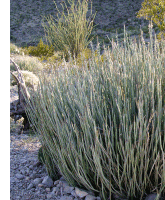Sample Request Request Data Sheet

CANDELILLA WAX
Candelilla Wax (Latin: Euphorbia Antisyphillitica), obtained from the plant of the same name, is a shrub growing wild in the Chihuahua desert, a semi-arid area of more than 100,000 square kilometers located between the two spines of the Sierra Madres in northeastern Mexico.
The common name of the Candelilla plant appears to have been derived from the particular shape of the plant stalks – long, straight, erect and wax-covered – giving the appearance of little candles. Wax is exuded in the form of grey-green scales on slender shoots or simple branched limbs of the reed-like plant offering protection from moisture loss.
Unitedwaxes.com is the world’s largest refiner of crude Candelilla Wax and produces a wax which conforms to the established USP/NF Monograph, the FCC (Food & Chemicals Codex) Grade. Our crude wax is sourced through established and reliable suppliers collected from sustainable sources.
Attractive and desired properties of Candelilla Wax include a moderate melting range, good gloss, durable film and a low coefficient of contraction. Candelilla Wax is valued in a variety of industries including cosmetics, pharmaceutical, confection and ink & coatings applications. Candelilla’s exceptional molding qualities capable of reproducing fine detail make it a superior precision casting wax. Properties, such as chemical stability, water repellency, high melting point, and good electrical resistance, make Candelilla useful in electronic and electrical products, liquid and paste polishes and waterproofing compounds.
Forms Available:
- Crude lump
- Refined lumps
- Flakes, powder and granules
Applications Include:
Cosmetics, Polishes,Pharmaceuticals, Precisions Casting, Lubricants, Adhesives, Paper Coating and Sizing, Chewing Gum Base, Electric Insulators, Candle Compositions
Compatibility:
Candelilla Wax is compatible with most vegetable and mineral waxes and a large variety of natural and synthetic resins.
| CANDELILLA WAX | ||||||||
| S&P Number | Melting Point |
Flash Point Minimum | Acid Value |
Saponification Value | Paraffinic Hydrocarbons |
Volatile Matter |
Insoluble Impurities | Color |
| 75 * | 68.5°C – 72.5°C | 12-22 | 43-65 | 45% Max. | Yellow | |||
| DR-405 | 68.5°C – 72.5°C | 12-22 | 50-65 | Yellow | ||||
| 75NF | 68.5°C – 72.5°C + | 12-22 | ||||||
| 99 | 68.5°C – 72.5°C | 12-22 | 43-65 | 45% Max. | Nil | Nil | Yellow | |
| 350 | 68.5°C – 72.5°C | 12-22 | 43-65 | 45% Max. | Yellow | |||
| DR-409 | 68.5°C – 72.5°C | 12-22 | 50-65 | Yellow | ||||
| * ECOCERT APPROVED | ||||||||
| + MEETS NF REQUIREMENTS | ||||||||
| CANDELILLA WAX POWDER | ||||
| S&P Number | 60 Mesh | 120 Mesh | 200 Mesh | 325 Mesh |
| 75P + | 98% | 70% | 30% | 10% |
| + MEETS FCC/ NF REQUIREMENTS | ||||
| PRIME QUALITY CRUDE | ||||||||
| S&P Number | Melting Point |
Flash Point Minimum | Acid Value |
Saponification Value | Paraffinic Hydrocarbons |
Volatile Matter |
Insoluble Impurities | Color |
| 78 | 68.5°C – 72.5°C | 241°C | 12-22 | 43-65 | 45% Max. | Nil | Nil | Tan |
| CANDELILLA WAX – SUBSTITUTE | ||||||||
| S&P Number | Melting Point |
Acid Value |
Saponification Value |
Color | ||||
| DR-415 | 73.0°C – 77.0°C | 12-22 | 50-65 | Yellow | ||||
| CANDELILLA WAX – SUBSTITUTE | ||||||||
| S&P Number | Melting Point |
Acid Value |
Saponification Value |
Color | ||||
| DR-415 | 73.0°C – 77.0°C | 12-22 | 50-65 | Yellow | ||||
Regulatory Status:
INCI NAME:
EU INCI:
CAS NUMBER
Candelilla Wax is FDA approved for end use under regulations 21CFR, 175.105, 175.320, 176.180, 184.1976 and is CTFA listed.
Candelilla Wax is GRAS listed
Candelilla wax is controlled under CITES
“This information relates only to the specific material designated in its pure described state and may not be valid for such materials used in combination with any other materials or in any process. Such information is to the best of Unitedwaxes.com’s knowledge and belief, accurate and reliable. However,no representation, warranty or guarantee is made as to its accuracy, reliability or completeness. It is the user’s responsibility to satisfy himself as to the suitableness and completeness of such information for his own particular use.”






